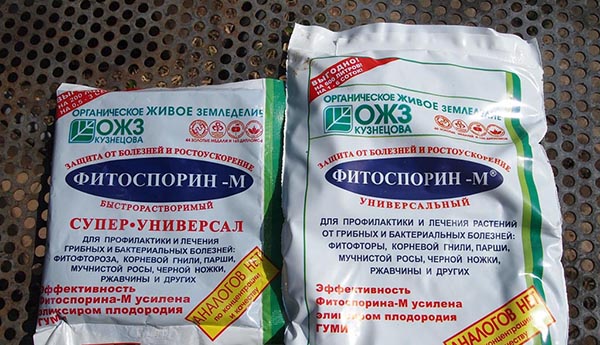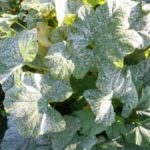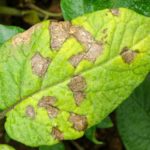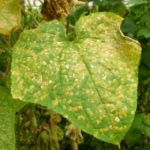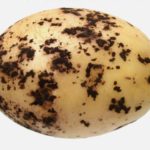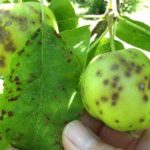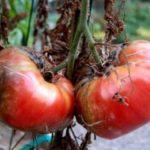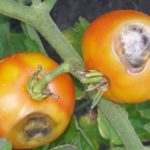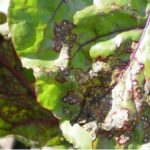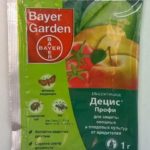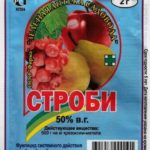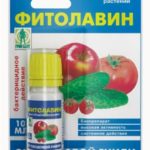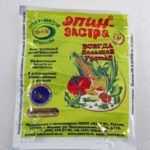The drug Fitosporin M is needed not only by summer residents, it is also necessary for gardeners and gardeners. Fungal and bacterial diseases are not only sick, garden and indoor ornamental plants, berry bushes and fruit trees suffer from them.
Table of contents
The composition and purpose of the drug Fitosporin M
On sale are various forms of the drug. These are different substances by structure:
- Paste.
- Suspension water.
- Powder.
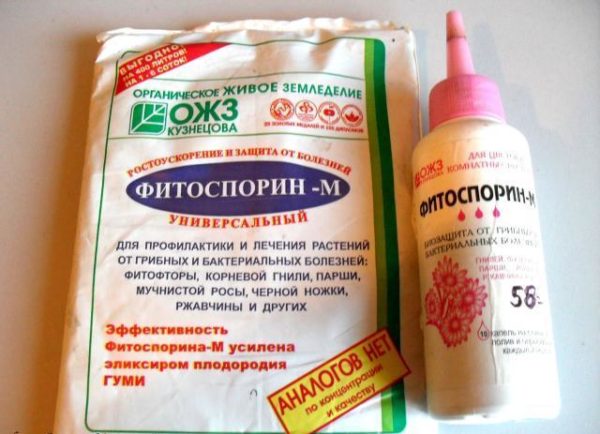
Efficiency does not depend on the form. The form only affects the duration of the cooking process. For example, the powder in water dissolves longer than the paste, so the preparation of the working mixture will take more time.
The powder can be gray (white) in color, stored for a long time without losing its properties. Suspension should be stored at room temperature, exclude freezing. Suspension is intended for flower growers engaged in indoor or greenhouse ornamental crops.
Phytosporin M according to the principle of action belongs to the group of systemic fungicides. Purpose - to stop the active reproduction of fungi and bacteria. Diseases with which he fights, or serves as their prevention:
- Alternaria
- Bacteriosis
- Black rot.
- Mealy dew.
- Scab.
- Rhizoctoniosis.
- Rust.
- Rot of tubers (wet, dry).
- Phytophthora.
- Fomoz.
- Fusarium.
- Cercospora
- Mealy dew
- Alternaria
- Bacteriosis
- Disease of potato tubers Rhizoctoniosis
- Scab
- Phytophthora on Tomatoes
- Fomoz
- Cercosporosis
The list is not all, it can be continued, there are many diseases, it does not make sense to list everything, the most common ones are given.
Active ingredient and mechanism of action
The active ingredient of the fungicide is a bacterial culture, its Latin name is Bacillus subtilis. The combination of bacteria produced by artificial means. The mechanism of action of Fitosporin is absolutely harmless to animals, humans, plants. It depressingly acts only on harmful microorganisms and fungal spores. The vascular system of plants is the way in which beneficial bacteria spread.
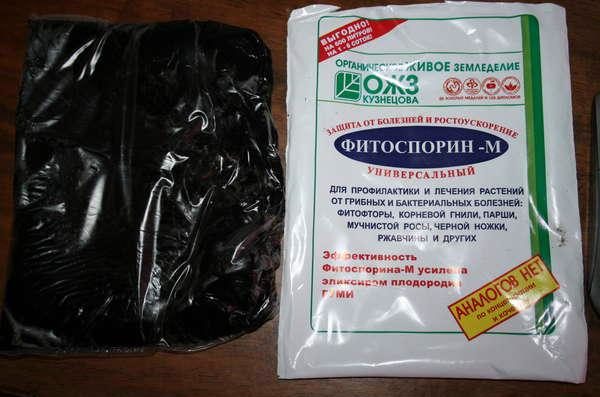
Useful bacteria, getting into the soil or on the leaves, the stems of plants, when spraying begin to multiply. The products of their vital activity inhibit the reproduction of the fungus, they kill it. The plant, having received the support of beneficial bacteria, restores its immunity and begins to actively fight the infection itself. The result is a plant with immunity.
Advantages and disadvantages compared with other means
Lack of toxicity is an important advantage of Fitosporin over insecticides and chemical agents. Real benefits:
- without fear of intoxication quietly spray flowers in the apartment;
- eat fruits almost immediately after spraying the bushes (trees).
Instructions for use
It is possible to apply the fungicide in any weather. The limit for outdoor treatments is rain. Recommend to carry out the processing of any crops after the rain. Must pass at least 3 hours.
Dosage for strawberries, potatoes, cucumbers and other crops
Rates of powder for different cultures are shown in table number 1.
| Culture name | The interval between treatments (day) | The rate of fungicide, the rate of water |
|---|---|---|
| flowers (indoor, garden) | 1 l - 1.5 g | |
| leaves, lash cucumbers | 14 | 10 liters - 10 g |
| tomato bushes | 14 | 10 liters - 5 g |
| potato bushes | 10 | 5 l - 10 g |
| cabbage leaves | 21 | 10 liters - 6 g |
| leaves, stalks of eggplant | 14 | 10 liters - 5 g |
| the soil | 10 liters - 5 g | |
| soaking tubers, bulbs | 30 | 0.5 l - 10 g |
| seeds - presowing treatment | 100 ml - 0.5 g | |
| seedlings roots | 5 l - 10 g |
The dosage of the aqueous concentrated pasta mixture is given in Table 2.
| Culture name | Processing time | The rate of fungicide, the rate of water |
|---|---|---|
| spraying all crops | 10 liters - 3 tbsp. l | |
| potted ornamental soil | 1 l - 15 drops | |
| spraying of tubers, bulbs | 1 tbsp - 3 tbsp. l | |
| seed soaking | 2 hours | 0.5 st - 2 drops |
| spraying decorative flower crops | Processing time | 1 l −10 drops |
| soaking cuttings | 1 tablespoon - 4 drops |
Preparation of working solution
The form by which the aqueous mixture is prepared will depend on the shape of the acquired biological product. From powder it is prepared immediately before work. Powder consumption is given in Table 1 above.
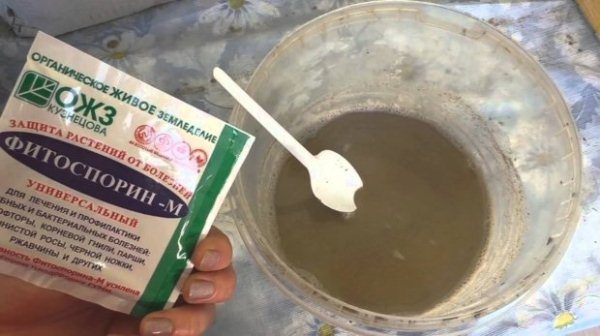
Paste is recommended to be used for water mixtures, observing the proportion of 1: 2. For example, 1 tbsp. l paste on 2 tbsp. l of water, per 100 g of a pack of pasta will need water 200 g. It should be understood that the resulting solution is very concentrated.
The norms of its consumption for different species of plants are given in the corresponding table No. 2. The concentrated solution can be stored for a long time. Suspension liquid, concentrated, it is dripped into water to obtain the desired concentration of the solution, for 1 tbsp. water requires 10 drops.
Terms and methods of processing plants
To prevent diseases, vegetable crops should be sprayed throughout the growing season. To prepare an aqueous mixture of the desired concentration, use a garden sprayer for spraying. The intervals between treatments are given in the first table, water mixture by volume 10 l will go for processing 100 square ridge
In the spring with the help of a solution of Fitosporin, treatment of planting material (tubers, seeds) is performed. On 1 bucket of seed potatoes will leave a solution of about 1 l. Potatoes need to moisten in it. During the flowering period with a solution, you can spray potato bushes to prevent diseases.
Cabbage seedlings (roots) dip before transplanting. Per 100 roots will need at least a liter of an aqueous solution (1 tsp. Of powder / 1 l.). It will take 10-12 days and cabbage leaves should be sprayed for the first time, then repeat the treatment every 10-12 days.
Tomatoes are treated at the seed stage. (according to table No. 1), when transplanting seedlings into the ground (soaking roots, Table No. 1), watering under the root 12 days after transplanting.Cucumbers need to be processed at the pre-planting stage, soaking the seeds. During the summer, sprinkle the stems and leaves 3 times, observing the interval indicated in the table.
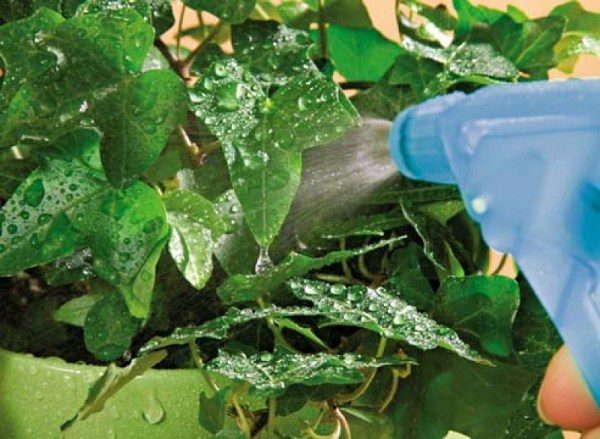
Any flowers (garden, indoor) spray for prevention at a given interval, the diseased flowers need to be watered (1.5 g of dry powder / 1 l). Processing of greenhouse structures and soil is carried out 7-10 days before planting, the concentration of the solution is 15g / 10 l.
Security measures when working with the tool
When preparing the solution and using it, be careful: wear working clothes, gloves, a gauze bandage or a respirator. Immediately flush mucous membranes (eye, mouth) if liquid is spilled on them.
Compatibility with other drugs
From plant pests and for the treatment of their diseases, summer residents use various chemical means, modern insecticides, stimulants, fungicides. Phytosporin fungicide m is compatible with almost all, with some exceptions.
Compatibility can be verified experimentally. It is necessary to prepare a small volume of a solution of 2 or more agents, the appearance of a precipitate indicates incompatibility, the absence of 100% compatibility, the possibility of applying to the treatment of plants. It is not necessary to add the fungicide in an alkaline solution, the precipitate in this case is guaranteed.
Fitoverma combinations with the following drugs were tested and effective:
- Decis;
- Fitolavin;
- Quadris;
- Strobe;
- Fundazole;
- Zircon;
- Platofol;
- Epin.
- Decis
- Strobe
- Fitolavin
- Fundazole
- Epin
These combinations can be used without fear.
Storage conditions and shelf life
Store Fitosporin packaging in the utility room, excluding access to animals and children. Purchased drug can be stored for a year. Permitted storage temperature from 2 to 30 ° C.
Reviews of gardeners and farmers on the use of Fitosporin M
Marina, cottage in the suburbs.This season I tried Fitosporin on different cultures: gooseberry, garlic, strawberry. A noticeable effect was on the garden with garlic, fungal diseases were not. In the gooseberry drug slowed down the development of powdery mildew, but not destroyed.I did not notice the positive effect of the drug on strawberries, the percentage of the disease of gray mold did not decrease. I concluded that this remedy should be used regularly to prevent diseases, and use stronger drugs for treatment.
Rimma, Ufa. Phytosporin M for many years I have served as the primary means for the prevention of disease. I usually buy pasta. I grow it and apply it on the same day. Before planting, I process with the solution all tuberous crops: vegetable - potatoes, flower - dahlias, every spring I spray all the shrubs with a fungicide. Before planting seedlings of beds for cucumbers, tomatoes I definitely spill Fitosporin.
The effect of a modern bacterial agent will be only with its systemic application. Expect benefits from one-time treatments is not worth it. Use a fungicide to treat basic vegetable crops during the summer, observing the intervals specified in the instructions.
